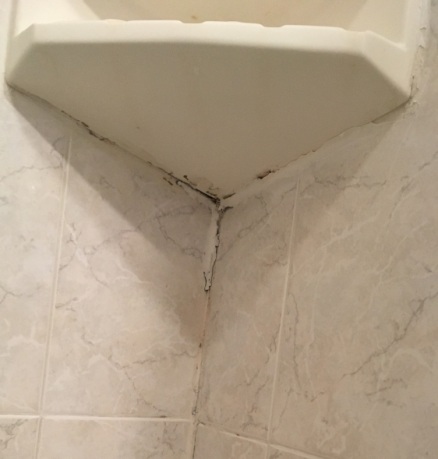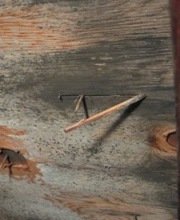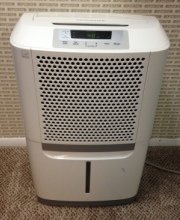Find a Mold Specialist Now
Click or Call, Toll-Free 24/7
Removing Black Mold in Shower
The growth of black mold in showers is an all too common occurrence. Showers and bathtubs are one of the most common locations for any kind of mold growth in the home. The steam produced by a hot shower, the crevices around the tiles, spigot, drain and shower head, and the shampoo bottles, shower curtain and other objects that tend to trap water, all contribute to an environment perfect for the growth of mold. Black mold in particular is a type of mold that thrives in damp areas like the shower. Understanding how to prevent and get rid of black mold in the shower is critical to maintaining your home and protecting your health.
What is Black Mold?
There are many types of mold, and many of them can be black in color. However, when people talk about “black mold” they are usually referring to a type of mold called stachybotrys chartarum. This mold produces toxic compounds called mycotoxins. Mycotoxins can cause serious health problems if you come into contact with them through the air or through touch. And because mold spores can spread so easily, you may come into contact with black mold without even realizing it.
Furthermore, black mold is just one type of mold that poses risks to your health. Many varieties of mold that commonly grow in the home act as allergens, causing nasal congestion, coughing, wheezing, eye irritation, skin rash and more. People with compromised immune systems, the elderly, and very young children are at greater risk for even more severe health problems. Black mold is a serious health risk and should be removed as soon as possible.
How to Remove Black Mold from the Shower
Cleaning mold requires killing the fungus completely so that it doesn’t continue to grow even after you’ve removed the surface growth. To do that, you need a household cleaner that disinfects and has the capacity to kill fungus such as mold. If you want a commercial disinfectant, we recommend RMR-141 Mold Killer. Alternatively, you can use a diluted bleach solution (1 cup of bleach mixed in 1 gallon of water).
Spray the disinfectant or bleach solution on the hard surfaces and allow to sit for a few minutes. Scrub with a rag or stiff brush, rinse with clean water, and allow to air dry. Repeat if necessary.
If mold has grown on the shower curtain, you can either clean it, or throw it away and buy a new curtain. To clean a small amount of mold, spray the curtain with disinfectant spray and scrub with a brush or rag. You can also wash the curtain in the washing machine using bleach. But the easiest way to ensure there’s no more mold on your shower curtain is to replace it.
Although cleaning black mold from a shower is generally not a dangerous task, you should wear latex or vinyl gloves to protect your skin from contact with the cleaning chemicals and the mold. We also recommend wearing an N-95 mask to avoid inhaling any mold spores. If the mold is widespread and appears difficult to clean, we recommend contacting a contractor or mold remediation specialist to remove the mold and re-caulk the shower.
Mold in Shower Caulking/Grout
 Black mold in shower grout
Black mold in shower groutMost tubs and showers have caulk and/or grout used as a sealant, and if your shower is made of tile, there may be a lot of it: in the corners, the tops and bottoms of walls, and at the base of the tub. Caulk and grout are susceptible to mold growth, and unfortunately, the mold cannot be completely removed. The mold grows into the caulk/grout, like roots grow into the ground. When you clean it, you are only removing the mold on the surface. The mold will slowly grow back. If you have mold growing in your shower caulking or grout, it should be removed and replaced.
You can find many helpful videos and instructions online for proper caulking/grouting techniques. If you’re re-caulking/grouting because of mold growth, it is critical to remember that you must remove all of the old caulk and grout, and clean any visible mold before applying new caulk/grout. Also make sure you purchase caulk/grout that is specifically rated for tubs and showers, because it will contain mold inhibitors.
Mold can easily get behind the tiles if the caulking/grout is compromised. If the tiles in your shower have gotten loose or you have staining on the walls behind your shower, the mold growth is likely more than a surface problem. Cleaning the mold is a good start but you will likely need more extensive mold remediation.
Preventing Mold Growth
The best way to deal with black mold in the shower is to prevent it in the first place. Mold thrives in humid and wet environments, and bathrooms frequently harbor moisture that can cause mold to grow quickly. Prevent moisture in the bathroom from causing mold growth by taking some simple, preventative steps.
Make sure your bathrooms are vented to the outside and run the fans during showers so steam doesn’t build up inside. If you don’t have a bathroom fan or it is no longer operating at full speed, get a new fan installed by a contractor. In the absence of a fan, open a window during showers, or run a portable dehumidifier to remove humidity from the air and help prevent mold growth.
Squeegee the shower and tub walls after you use the shower each time so it dries faster.
Repair plumbing leaks promptly. If you see or suspect a leak around your shower, sink or toilet, take steps to repair the leak or call a plumber immediately.
Finally, but most importantly, clean your tub and shower frequently! By maintaining a regular cleaning schedule, you can remove tiny bits of mold before they become invasive problems that require expensive repairs. Weekly shower cleanings should be enough to maintain a clean shower.
Get Professional Help
Mold must always be removed promptly to prevent expensive and extensive damage to your home. If you suspect you have a major mold problem, you can use this form to get a list of mold remediation professional in your area. Local mold professionals can help identify the extent of your mold problem, and provide a free home inspection and estimate for any needed mold remediation work.
Return From Black Mold In Shower To Our Main Bathroom Mold Page
Privacy Policy Terms and Conditions Accessibility Do Not Sell My Information Disclaimer Contact Us





